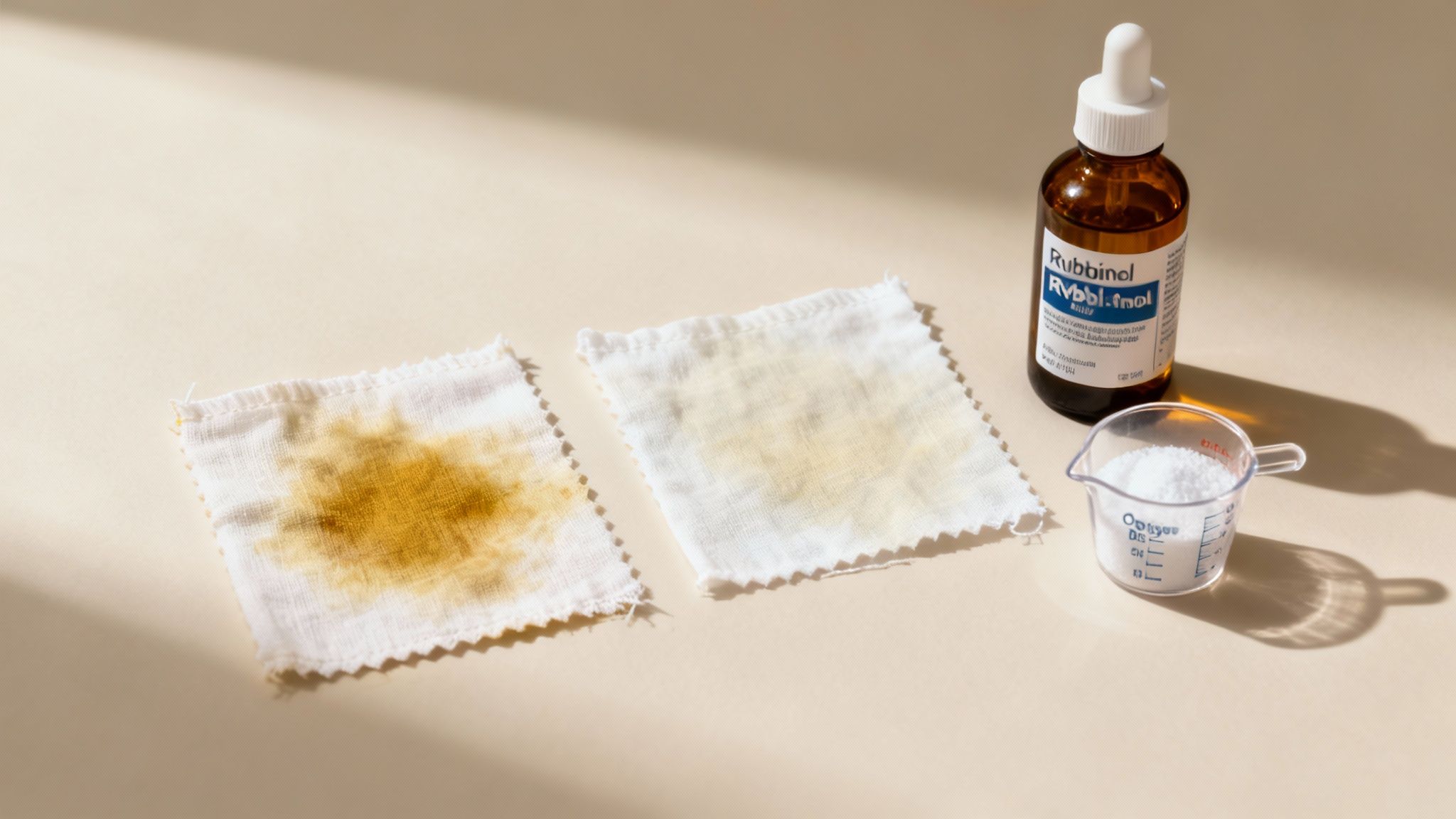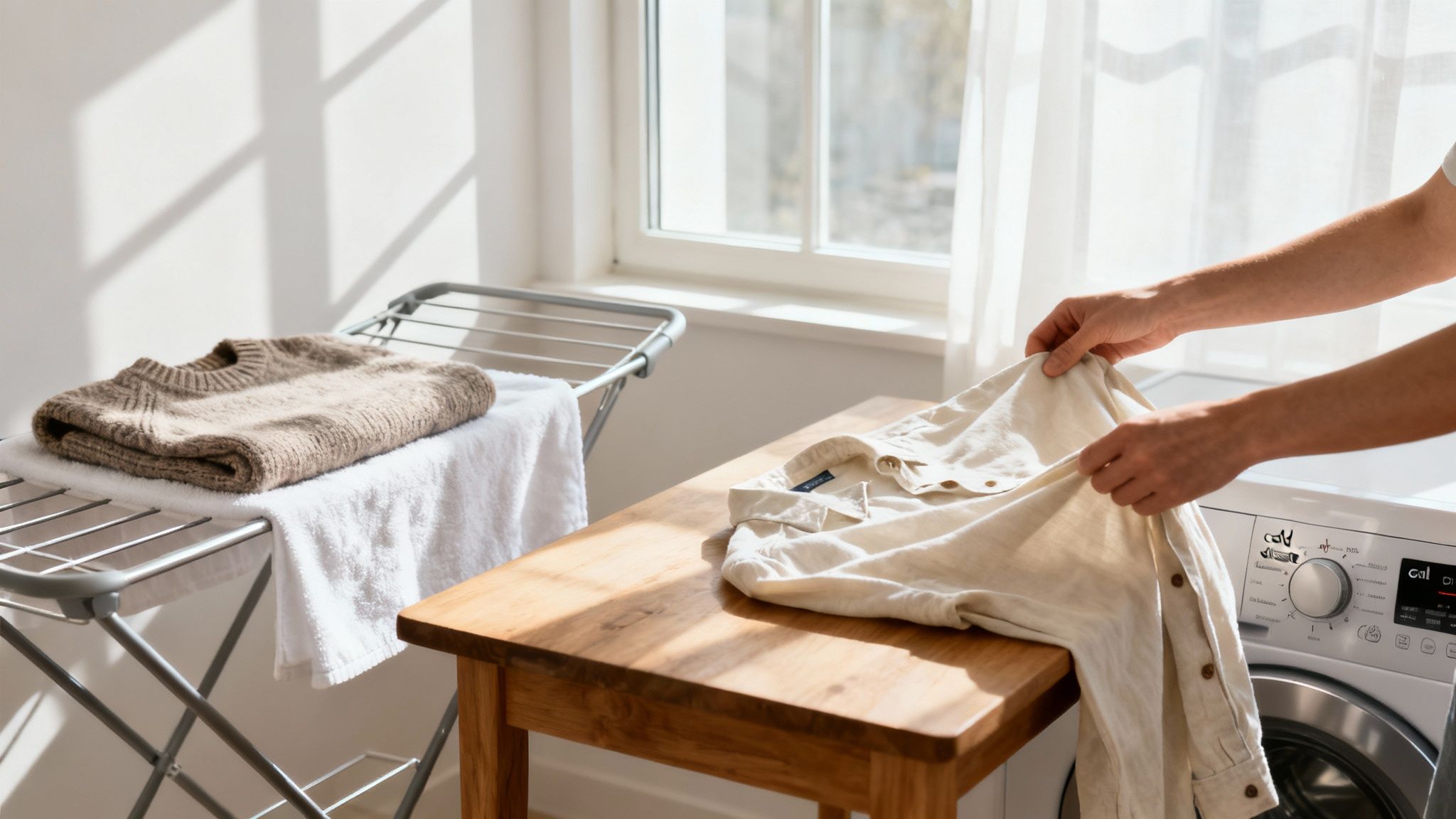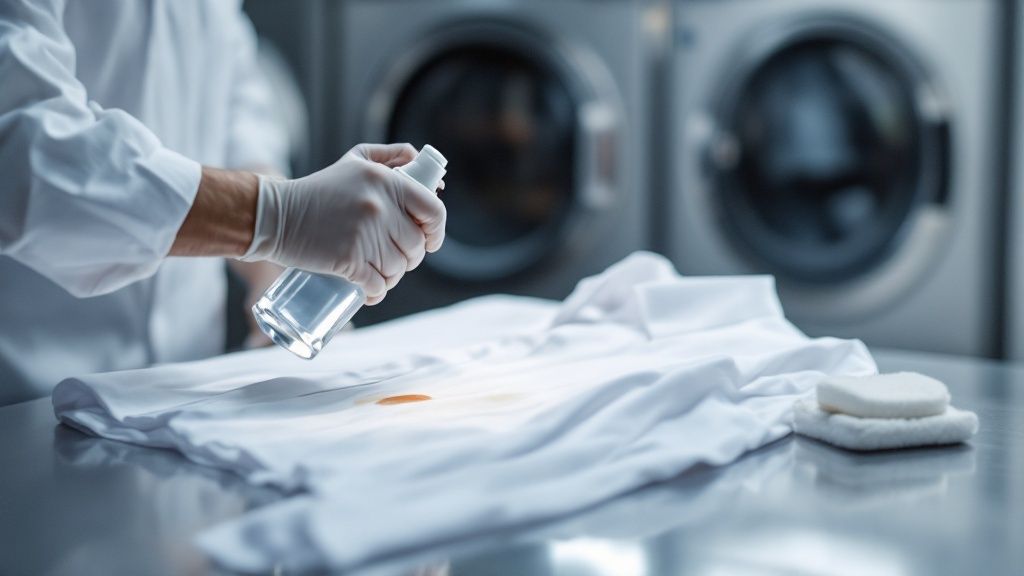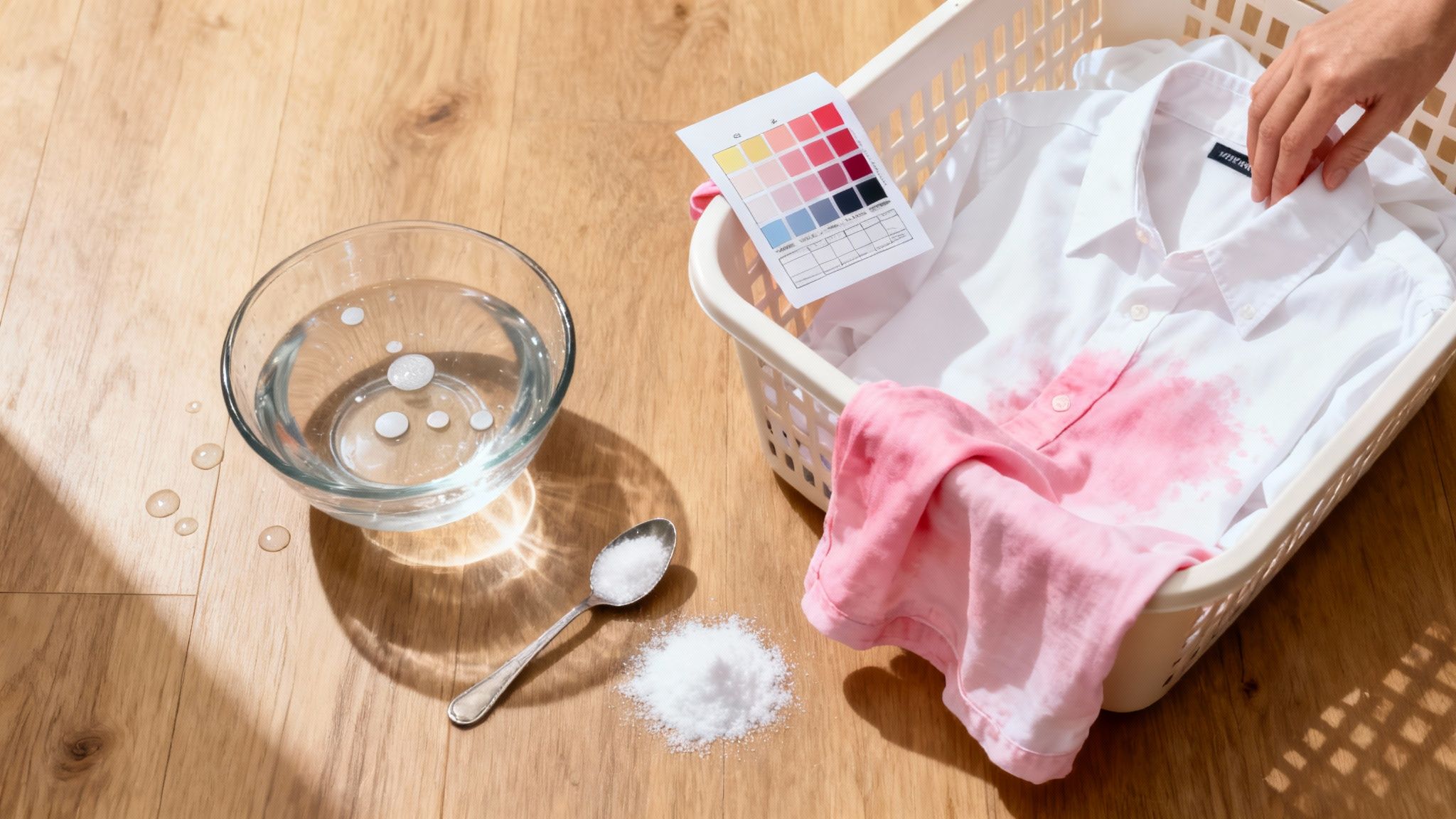How to Remove Mustard Stains from Clothes Fast

That bright yellow splotch isn't just a simple spill; it's what I call a perfect storm of staining agents. Knowing how to remove mustard stains from clothes really comes down to understanding the enemy: a nasty trio of pigment, oil, and acid that work together to bond with fabric almost instantly.
The bad news? It's a tough stain. The good news? Acting fast is your best defense against it becoming a permanent feature on your favorite shirt.
Why Mustard Stains Are So Stubborn

Ever notice how a tiny drop of mustard seems to spread into a formidable, almost glowing, stain? It’s not your imagination. Mustard stains are notoriously difficult because their chemical makeup is a triple threat.
The main culprit is turmeric, the spice that gives mustard its iconic vibrant color. Turmeric contains curcumin, a powerful pigment that is basically a natural dye, just waiting to latch onto fabric fibers for dear life.
But the pigment doesn't do its dirty work alone. Mustard has a couple of sidekicks that help the stain set in deeply and quickly:
- Vinegar: The acid in vinegar helps the turmeric pigment penetrate and chemically bond with the fabric.
- Oils: Many mustard recipes contain oil, which creates a greasy shield that repels water, making the stain much harder to flush out with a simple rinse.
This combination requires a specific battle plan to break down each component. It’s a bit of a science experiment, really. We get into the nitty-gritty of this in our guide on how stain removers work for every stain type.
The Urgency of Quick Action
When it comes to a fresh mustard spill, time is your greatest enemy. The longer that stain sits, the more time the turmeric has to permanently dye the fabric and the oils have to seep deeper into the threads. An untreated mustard stain can become permanent in as little as 24 hours.
The moment a spill happens, you're in a race against the clock. Immediate action can prevent the pigment from permanently bonding to the fabric, turning a potential disaster into a manageable cleanup.
This urgency is why the global market for stain removal products is so massive. Think about it: with over 700 million pounds of mustard consumed annually worldwide, these yellow accidents are a super common household problem. The global stain remover market, valued at over USD 21 billion in 2023, exists because of stubborn food stains like this.
Acting quickly gives you a huge advantage before you even reach for a cleaning solution.
Immediate Action Plan for Mustard Spills
That hot dog just dripped all over your new white shirt. Don't panic! The first few minutes are critical. Here’s a quick-reference table for what to do right away to give yourself the best shot at getting the stain out completely.
Following these initial steps can turn a potential laundry catastrophe into a minor inconvenience. It’s all about working smart, not hard, especially in those first crucial moments.
The First Steps for Treating Any Fabric
So, you’ve just had a hot dog mishap, and now there's a bright yellow splotch on your favorite shirt. Don't panic. Before you even think about reaching for a stain remover, what you do in these first few seconds is absolutely critical.
Getting these initial moves right can be the difference between a stain that vanishes without a trace and one that decides to stick around for good.

First things first, get rid of any excess mustard sitting on top of the fabric. Grab a spoon or the dull edge of a butter knife and gently lift off the blob. The goal here is to scrape, not wipe. Wiping or mashing it with a napkin will just grind that yellow pigment deeper into the fibers, and that's a headache you don't need.
Once the glob is gone, your next instinct might be to rub at the spot. Fight that urge! Rubbing is your worst enemy here. Instead, take a clean, dry cloth or paper towel and gently blot the area. You're trying to soak up as much of the liquid and color as possible without spreading it around.
Flushing the Stain the Right Way
After you've blotted up the excess, the next step is non-negotiable: flush it with cold water. But there's a trick to it. You have to do it from the back of the fabric.
Turn the stained part of your shirt inside out and hold it directly under a cold running tap. By forcing the water through the reverse side, you’re pushing the mustard particles back out the way they came in. If you flush from the front, you’re just helping the stain dig itself deeper into the material.
Knowing your material is half the battle when it comes to stain removal. For a deeper dive into general fabric care, you might find some good tips on how to clean various fabric surfaces.
Pro Tip: Whatever you do, do not use hot water in these initial stages. Heat will chemically set the proteins and pigments in the mustard, basically cooking the stain right into the fibers. It's the fastest way I know to make a temporary problem permanent.
Why Cold Water Is Your Best Friend
The logic is pretty simple. Cold water helps keep the fabric's fibers from constricting, which makes it easier to flush out the stain particles—especially the turmeric that gives mustard its vibrant (and stubborn) color.
So, let's recap your immediate action plan:
- Lift, don't press: Scrape away any solid bits of mustard first.
- Blot, don't rub: Gently soak up the liquid without smearing the stain.
- Flush from the back: Use cold water to push the stain out of the fibers.
Mastering these first few moves is like triage for your clothes. It preps any fabric, from tough denim to delicate cotton, for the more targeted cleaning treatments to come and gives your garment the best possible chance of a full recovery.
Using Simple Pantry Items to Lift Stains

Once you've scraped away the excess mustard and flushed the spot, you don't need to race out for a special stain remover. Believe it or not, some of the best tools for learning how to remove mustard stains from clothes are probably sitting in your kitchen right now. These simple, everyday items can be surprisingly mighty against that stubborn yellow pigment.
Before you dive in, it’s always a good idea to do a quick patch test on a hidden seam or the inside hem. This just makes sure the treatment won't cause any unexpected color changes on your specific fabric.
The Vinegar and Dish Soap Method
One of the most reliable DIY teams is a simple mix of white vinegar and a gentle dish soap. This duo works together to break down the different parts of a mustard stain.
Think of it this way: the dish soap is a degreaser, so it gets to work on the oils within the mustard. Meanwhile, the mild acid in the white vinegar helps dissolve the turmeric pigment that’s responsible for that vibrant yellow. It's a classic one-two punch for food stains.
Making this solution couldn't be easier:
- Combine about half a teaspoon of clear dish soap with a few drops of white vinegar.
- Add the mix to about half a cup of cool water and give it a stir.
- Gently dab the solution onto the stain with a clean cloth. Let it sit for about 10-15 minutes.
- Once it's had time to work, flush the area from the back again with cold water.
This method is a champ on durable fabrics like cotton and denim. If you're working with something more delicate like silk or wool, just be extra gentle and blot carefully so you don't damage the fibers.
Harnessing the Power of Baking Soda
Baking soda is another fantastic pantry staple for stain removal, and it’s especially good at lifting pigments from the surface of the fabric. Its nature is slightly abrasive but still gentle, which helps pull the turmeric out without being too harsh.
All you have to do is create a simple paste by mixing baking soda with a little cool water until it has a toothpaste-like consistency. Spread this paste directly onto the mustard stain, making sure it's completely covered, then let it sit until it dries.
The real magic happens as the baking soda paste dries. It actively works to absorb and lift the stain's pigment right off the fabric's surface. Once it's dry, you can gently scrape it away and see the difference.
After you've removed the dried paste, give the area a thorough rinse with cold water. This approach is an excellent pre-treatment step before trying something stronger if you're dealing with a really stubborn stain.
When to Bring in a Little Extra Help
For those really tough stains on white or light-colored clothes, you might need to call in a slightly stronger pantry solution. Mixing a bit of hydrogen peroxide with dish soap can create a powerful stain-fighting agent. Just be careful. For a deep dive into its effects, you can check out our guide on whether hydrogen peroxide stains clothes before you give this a go.
Always, always test hydrogen peroxide on a hidden spot first, as it can have a mild bleaching effect on some colored fabrics. When you're ready, here’s a quick recipe:
- Mix: Combine 1 part hydrogen peroxide with 2 parts dish soap.
- Apply: Gently work the solution into the stain using a soft brush or just your fingertip.
- Wait: Let it sit for about 10 minutes, but don't let it dry on the fabric.
- Rinse: Flush the area completely with cool water before tossing it in the wash.
These simple pantry fixes prove you don't always need harsh chemicals to win the war on mustard. With a little patience and the right household ingredients, you can get your clothes back to looking their best.
Tackling Tough and Set-In Mustard Stains

We've all been there. You don't notice the rogue mustard drip until hours later when it's a crusty, yellow beacon on your favorite shirt. Or worse, you pull a "clean" shirt from the dryer only to find a faded, heat-set stain staring back at you.
Don't give up on that garment just yet. This is where we need to bring out the heavy hitters.
A set-in stain is basically a dehydrated, deeply bonded mess. The first order of business is to "rehydrate" it to make it workable again. A little water or a simple cleaning solution will soften the stain, getting it ready for a more serious treatment.
Breaking Down Stubborn Pigments
For those really defiant, set-in stains, you need something that can go in and dissolve the pigments that have basically fused with the fabric fibers. Two of the best tools for this job are rubbing alcohol and glycerine, both of which you can easily find at a local drugstore.
- Rubbing Alcohol: This acts as a solvent, cutting through the oily parts of the mustard and that vibrant turmeric dye. Just put a little on a clean white cloth and gently blot the stain, working from the outside edges inward to keep it from spreading.
- Glycerine: This stuff is a fantastic pre-treatment for old stains. I like to warm the bottle slightly under some warm tap water, then apply it directly to the spot. It works to loosen and lift the pigment, making it much easier to wash out later. Give it at least an hour to do its thing before you even think about laundering it.
After using either of these methods, you'll want to rinse the area thoroughly with cold water before you proceed to the final wash. Patience is everything here—these stains didn't set in an instant, and they won't disappear in one, either.
When you're up against a tough stain, the pre-treatment phase is your make-or-break moment. You aren't just cleaning; you're performing a targeted rescue mission on the fabric itself. Rushing this step is the number one reason people fail.
Choosing the Right Kind of Bleach
When you hear the word "bleach," you probably think of the harsh chlorine kind that can strip color right out of your clothes. For mustard stains, especially on anything with color, oxygen-based bleach (like OxiClean) is your best friend.
Unlike chlorine bleach, which can wreck fibers and ruin dyes, oxygen bleach is color-safe. It works by breaking down the organic compounds in the stain without damaging the fabric.
If the stain is still hanging on after other treatments, mix up a solution of oxygen bleach and cool water, following the directions on the package. Submerge the entire piece of clothing and let it soak for several hours—or even overnight. This long soak gives the solution time to work its way deep into the fibers and lift that last bit of yellow.
And sometimes, you just have to call in the pros. Expert dry cleaners can often remove stains that seem absolutely permanent at home.
The strategies for tough food stains often overlap. Learning how to handle other difficult spills can add to your stain-fighting arsenal. For instance, knowing how to get curry stain out of your clothes is useful because it also involves battling that intense turmeric pigment. With the right game plan, even a set-in mustard stain doesn't have to be a death sentence for your favorite shirt.
The Final Wash and Post-Treatment Check
You've done the hard work of pre-treating, and now you're on the home stretch. But don't get ahead of yourself—this final wash is what really seals the deal. Getting this part right will wash away any leftover stain particles, but the wrong move could lock that yellow pigment in forever.
First things first, check the garment's care label. That little tag is your best friend for figuring out the right water temperature. As a general rule, you’ll want to use the warmest water the fabric can safely handle. For sturdy fabrics like cotton or synthetics, that usually means a warm cycle. For anything delicate like silk or wool, stick with cold water.
When it comes to detergent, grab a high-quality liquid one. I've found that enzyme-based detergents are especially brilliant here. Their enzymes are specifically designed to break down the organic gunk in food stains like mustard, giving you an extra bit of cleaning muscle in the wash.
The Most Important Rule: Air-Dry Only
Whatever you do, do not toss the garment into the machine dryer after this wash. This is the single most important rule to remember. The intense heat from a dryer will permanently set any faint, lingering traces of the stain, making them impossible to get out later.
Instead, hang the item up to air-dry. You can do this indoors on a rack or outside in a shady spot. A little indirect sunlight can sometimes help, especially with white fabrics, but direct sun can be risky for colors. Only once the garment is completely dry can you give it a proper inspection.
Crucial Takeaway: A hot dryer is the enemy of a stubborn stain. It basically acts like a kiln, baking any leftover pigment into the fabric's fibers for good. Always air-dry the item until you are 100% certain the stain is gone.
Inspecting Your Work and What to Do Next
Once the fabric is bone dry, take it to a well-lit spot—near a window is perfect—and really examine the area where the stain was. Tilt it back and forth to see if you can spot any faint yellowing from different angles.
If the stain has vanished, awesome! You can now wash and dry the item just like you normally would. It’s officially back in rotation.
But if you still see a ghostly shadow of the stain, don't panic. This is super common, especially with the turmeric in mustard. Just repeat the pre-treatment steps that worked for you before—whether that was the vinegar solution, rubbing alcohol, or an oxygen bleach soak—and run it through another wash cycle. A little patience is all you need; some tough mustard stains just require a second round to be completely knocked out.
Your Top Mustard Stain Questions, Answered
Even when you know the basic steps, some situations can throw you for a loop. What do you do if that bright yellow blotch lands on your favorite silk blouse? Or what if you're at a ballpark, miles away from your laundry room? Let's dive into some of those tricky "what if" scenarios that always seem to pop up.
Think of this as your go-to troubleshooting guide for mustard stain emergencies.
What If I Get Mustard on Silk or Wool?
Okay, take a deep breath. Delicate fabrics like silk and wool need a much gentler approach. You can't just scrub them or hit them with the heavy-duty stuff you'd use on a cotton t-shirt—that's a surefire way to damage their delicate fibers.
For these materials, your best friend is a simple, mild solution. Just mix a few drops of a pH-neutral detergent (like a special wool wash) into a cup of cool water. Gently dab the solution onto the stain with a clean, white cloth. Whatever you do, don't rub! To rinse, just blot the area with another cloth dampened with plain water. Patience is everything here; you might need to repeat this gentle dabbing process a few times to see results.
Should I Use a Commercial Stain Remover?
Absolutely. Commercial stain removers can be lifesavers, and it's always a good idea to have a trusted one in your laundry arsenal. There's a reason the global market for these products is massive—valued at USD 21.48 billion in 2023, the industry is booming because people need real solutions for stubborn stains like mustard. You can find more details about the stain remover market on archivemarketresearch.com.
When you're picking out a commercial product, look for one that’s designed for enzyme or pigment-based stains. These formulas are specifically engineered to break down the organic compounds in mustard, especially that notoriously stubborn turmeric.
Just remember to always follow the directions on the bottle and do a quick spot test on a hidden part of the garment first. You want to make sure it won't cause any discoloration before you go all in. These removers are a fantastic backup when your DIY methods just aren't cutting it.
How Do I Handle a Stain on the Go?
You're out, enjoying a hot dog, and it happens—the dreaded mustard drip. Don't panic. You might not be able to do a full-blown treatment right then and there, but a little quick thinking can seriously minimize the damage.
- Scrape It Off: Grab the edge of a credit card or a plastic knife and gently lift off any excess mustard right away.
- Blot, Don't Rub: Find a restroom and use a damp paper towel to carefully blot the stain. This helps dilute the yellow pigment without spreading it into a bigger mess.
- Use What You've Got: In a pinch, a little bit of hand sanitizer can act as a solvent. Put a tiny dab on the spot and blot it gently.
These immediate actions can stop the stain from setting deep into the fabric, which will make it much, much easier to get out once you're back home. For now, it's all about damage control.
Still staring at a mustard stain that refuses to budge? Sometimes, you just have to call in the professionals. At Columbia Pike Laundry, we give your clothes the expert care they need, so you can get back to your life. Schedule your first pickup today and let us handle the laundry stress for you.
Popular Blog Articles

Meet the Author
Daniel Logan didn’t start CPL because he loved laundry. He started it because his family was drowning in time debt, and laundry was one of the biggest weights.
Mornings were chaos with two kids under 5. Evenings felt like catch-up. And weekends? Gone to sorting socks and folding piles.
He knew his story wasn’t unique. So he built a business that gave families like his just a little bit of breathing room one load at a time.
With no laundry experience but deep tech skills, Daniel rolled up his sleeves, doing every job himself while building systems that turned it into a modern laundry service that saves customers time, simplifies their lives, and delivers reliability they can count on.
That’s where CPL began. Not from a playbook, but from pain. From one dad trying to buy back time: for himself, and for every household like his.








